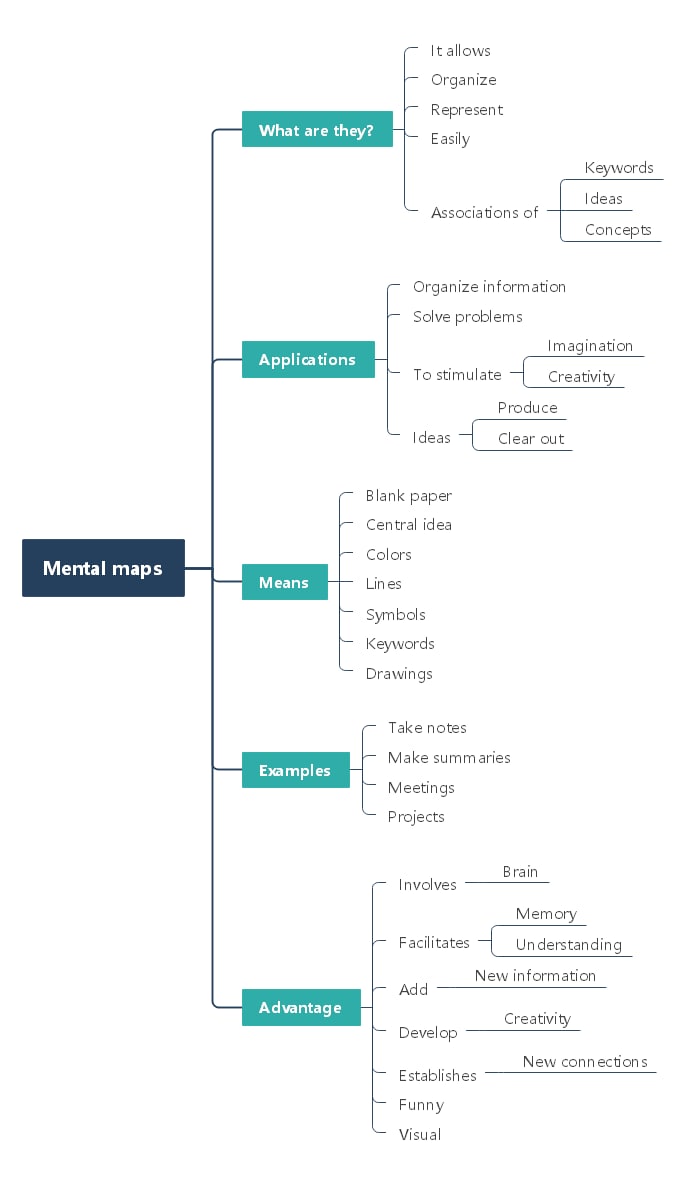
In this article
What is a Mental Map
Mental maps fall under behavioral geography as they help understand a person's perspective of their surroundings. It can include any depiction of their family members, their internal/external environment, etc.
By default, our brain keeps creating mental maps for our surroundings and guides us on how to interact and behave in a certain environment. For instance, how we behave in the office would be completely different from how we behave with our friends at any celebration.
Some of the elements of a mental map are:
- Spatial Information: As mentioned in the above example, a mental map helps individuals navigate through different physical spaces. It also helps us remember particular locations.
- Hierarchies: In mental maps, we always create hierarchies that categorize and prioritize the information based on ideas or concepts.
- Associations: Like any other concept map, mental maps are built on associations and help convey related information between nodes and entities.
Benefits of Mental Map
Mental maps offer immense help in different domains, including project management. Several small to large organizations create mental maps when it comes to delivering a project to a client or ensuring that the projects are running without any bottlenecks.
Some of the benefits of creating a mental map for project management are:
- Improved Clarity: A mental map following a particular hierarchy helps provide a visual representation of project details. This way, teams get the entire process and information in a more structured manner.
- Optimized Planning: When project managers create detailed mental maps to break down tasks, timelines, and dependencies on resources, they lead a more efficient planning and resource allocation.
- Better Communication: When different team members work on different projects, there comes a time when communication starts to go downhill. In those scenarios, a mental map comes in handy as it serves as a common visual language that ensures everyone understands the project's progress and objectives.
- Effective Problem-Solving: With detailed mental maps, project managers can easily assess the different impacts of changes on project structures.
- Adaptability: Mental maps are created keeping the project's primary objective in mind. With the ever-changing environment, mental maps have proved to be extremely flexible and can even be adapted as the project evolves.
How to Make a Mental Map
Creating a detailed mental map with associations and hierarchies is technically a cognitive process. If you are planning to create a mental map for your projects, check out the following step-by-step guide:
Step 1:Define Central Idea
The first step in creating a mental map is identifying the central topic. By brainstorming on the central idea, everyone in the team will understand the objective they must follow.
Gather Information: Start collecting all the relevant information that is related to the central concept. Add these keywords, important points, and supporting details in and around the central topic.
Step 2: Establish Hierarchies
Start by identifying the main categories and subcategories of the central topic and arrange them logically. Remember that these hierarchies will be the backbone of the mental map. So, create them according to the researched material.
Step 3: Create Connections
Using the right mental map software, start showing relationships between different pieces of information. The right tool will let you add lines, arrows, connectors, and summary sections to illustrate connections by providing detailed information on associations between ideas.
Step 4: Review & Share
Once you have added different subtopics and analyzed the overall hierarchy, start reviewing the gathered information to learn if you have missed adding any relevant relationship between ideas. Once reviewed, you can share the mental map with your peers for them to analyze and further evaluate it.
Examples of Mental Map

In the following example of a mental map, we have created a generic structure diagram showing the meaning and importance of creating a mental map. As you can see from the psychology concept map diagram, we have added different subtopics to explain mental maps in detail. From the 'Applications' subsection, we have depicted different applications of mental maps. Whereas, from the 'Advantages' subsection, we have outlined a few advantages of creating a mental map.
This is an elaborated mental map depicting trauma and different aspects of it. As illustrated in this mental map template, trauma is a reaction to distributing occurrences that overwhelm a person's ability to move on and even imbibe a feeling of powerlessness. By creating such a mental map, we can understand the WHO's take on it and how different studies are conducted to understand the cause and effect of trauma in different individuals.
Mental Map Software

As we understood in the above mental map examples and a step-by-step guide to creating one, with the right software, the process of making a mental psychology concept map becomes easier. Creating a mental map manually or traditionally is still possible, but it will limit your creativity and create hindrances when you want to revise or share it with your peers.
That being said, we highly recommend using a mental map software that provides templates, editability, visual elements, collaboration features, and more. When you plan to create mental maps for your project management or other domains, check out EdrawMind. This mental map software offers free templates, cliparts, brainstorming layouts, Gantt charts, and more.
Conclusion
Mental maps are a versatile tool that helps individuals and project managers to organize their thoughts and navigate through complex information. By understanding what mental maps are and how to create them, one can easily unlock the potential to improve problem-solving and communication skills. When you plan to create a mental map, try embracing mental map software like EdrawMind to elevate your concept mapping experience. The tool not only provides multiple shapes and layouts but comes with built-in templates and a wide range of visual customization options.
FAQ
-
What is the difference between a cognitive map and a mental map?
A cognitive map is a mental illustration or depiction of a given physical environment (both internal and external). On the other hand, a mental map is not limited to the physical environment only but also includes different types of information gathered from multiple sources. -
What is a mental map also called?
Organizations and individuals often refer to mental maps as cognitive maps, psychology concept maps, or sometimes simply concept maps. In all the cases, the functionality of the mental map remains the same. -
How do mental maps work?
A mental map works by organizing different information in a way that the hierarchy represents all the associations and meanings of all the sub-topics. By creating the core concept and illustrating its overall objective, a mental map improves overall productivity.





 below.
below.  below.
below. 